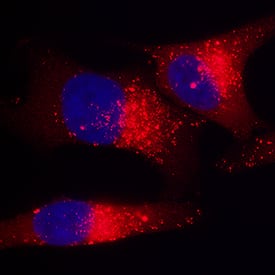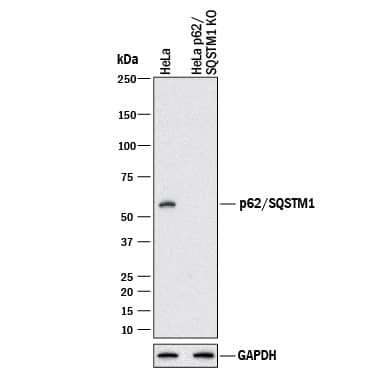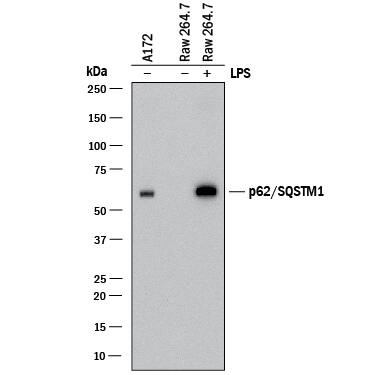Human/Mouse/Rat p62/SQSTM1 Antibody
R&D Systems, part of Bio-Techne | Catalog # MAB8028R
Recombinant Monoclonal Antibody.

Key Product Details
Validated by
Knockout/Knockdown, Biological Validation
Species Reactivity
Validated:
Human, Mouse, Rat
Cited:
Human
Applications
Validated:
Immunocytochemistry, Immunoprecipitation, Knockout Validated, Western Blot
Cited:
Immunocytochemistry, Immunoprecipitation, Western Blot
Label
Unconjugated
Antibody Source
Recombinant Monoclonal Mouse IgG2B Clone # 864807R
Product Specifications
Immunogen
E. coli-derived recombinant human p62/SQSTM1
Asp368-Leu440
Accession # Q13501
Asp368-Leu440
Accession # Q13501
Specificity
Detects human p62/SQSTM1 in ELISAs. Detects human, mouse and rat p62/SQSTM1 in Western blots
Clonality
Monoclonal
Host
Mouse
Isotype
IgG2B
Scientific Data Images for Human/Mouse/Rat p62/SQSTM1 Antibody
Detection of Human and Mouse p62/SQSTM1 by Western Blot.
Western blot shows lysates of A172 human glioblastoma cell line and RAW 264.7 mouse monocyte/macrophage cell line untreated (-) or treated (+) with 10 µg/mL LPS for 4 hours. PVDF membrane was probed with 1 µg/mL of Mouse Anti-Human/Mouse/Rat p62/SQSTM1 Monoclonal Antibody (Catalog # MAB8028R) followed by HRP-conjugated Anti-Mouse IgG Secondary Antibody (Catalog # HAF018). A specific band was detected for p62/SQSTM1 at approximately 62 kDa (as indicated). This experiment was conducted under reducing conditions and using Immunoblot Buffer Group 1.p62/SQSTM1 in HeLa Human Cell Line.
p62/SQSTM1 was detected in immersion fixed HeLa human cervical epithelial carcinoma cell line treated with staurosporine using Mouse Anti-Human/Mouse/Rat p62/SQSTM1 Monoclonal Antibody (Catalog # MAB8028R) at 3 µg/mL for 3 hours at room temperature. Cells were stained using the NorthernLights™ 557-conjugated Anti-Mouse IgG Secondary Antibody (red; Catalog # NL007) and counterstained with DAPI (blue). Specific staining was localized to cytoplasm. View our protocol for Fluorescent ICC Staining of Cells on Coverslips.Western Blot Shows Human p62/SQSTM1 Specificity Using Knockout Cell Line.
Western blot shows lysates of HeLa human cervical epithelial carcinoma parental cell line and p62/SQSTM1 knockout HeLa cell line (KO). PVDF membrane was probed with 1 µg/mL of Mouse Anti-Human/Mouse/Rat p62/SQSTM1 Monoclonal Antibody (Catalog # MAB8028) followed by HRP-conjugated Anti-Mouse IgG Secondary Antibody (Catalog # HAF018). A specific band was detected for p62/SQSTM1 at approximately 62 kDa (as indicated) in the parental HeLa cell line, but is not detectable in the knockout HeLa cell line. GAPDH (Catalog # MAB5718) is shown as a loading control. This experiment was conducted under reducing conditions and using Immunoblot Buffer Group 1.Applications for Human/Mouse/Rat p62/SQSTM1 Antibody
Application
Recommended Usage
Immunocytochemistry
3-25 µg/mL
Sample: Immersion fixed HeLa human cervical epithelial carcinoma cell line treated with staurosporine
Sample: Immersion fixed HeLa human cervical epithelial carcinoma cell line treated with staurosporine
Immunoprecipitation
1 µg/1 mg cell lysate
Sample: Cell lysate of U2OS human osteosarcoma cell line
Sample: Cell lysate of U2OS human osteosarcoma cell line
Knockout Validated
p62/SQSTM1 is specifically detected in HeLa human cervical epithelial carcinoma parental cell line and parental U2OS cell line but is not detectable in p62/SQSTM1 knockout HeLa cell line and knockout U2OS cell line.
Western Blot
1 µg/mL
Sample: A172 human glioblastoma cell line and RAW 264.7 mouse monocyte/macrophage cell line treated with LPS
Sample: A172 human glioblastoma cell line and RAW 264.7 mouse monocyte/macrophage cell line treated with LPS
Formulation, Preparation, and Storage
Purification
Protein A or G purified from cell culture supernatant
Reconstitution
Reconstitute at 0.5 mg/mL in sterile PBS. For liquid material, refer to CoA for concentration.
Formulation
Lyophilized from a 0.2 μm filtered solution in PBS with Trehalose. *Small pack size (SP) is supplied either lyophilized or as a 0.2 µm filtered solution in PBS.
Shipping
Lyophilized product is shipped at ambient temperature. Liquid small pack size (-SP) is shipped with polar packs. Upon receipt, store immediately at the temperature recommended below.
Stability & Storage
Use a manual defrost freezer and avoid repeated freeze-thaw cycles.
- 12 months from date of receipt, -20 to -70 °C as supplied.
- 1 month, 2 to 8 °C under sterile conditions after reconstitution.
- 6 months, -20 to -70 °C under sterile conditions after reconstitution.
Background: p62/SQSTM1
Long Name
Sequestosome 1
Alternate Names
A170, EBIAP, ORCA, OSIL, PDB3, Sequestosome 1, SQSTM1, ZIP3
Gene Symbol
SQSTM1
UniProt
Additional p62/SQSTM1 Products
Product Documents for Human/Mouse/Rat p62/SQSTM1 Antibody
Product Specific Notices for Human/Mouse/Rat p62/SQSTM1 Antibody
For research use only
